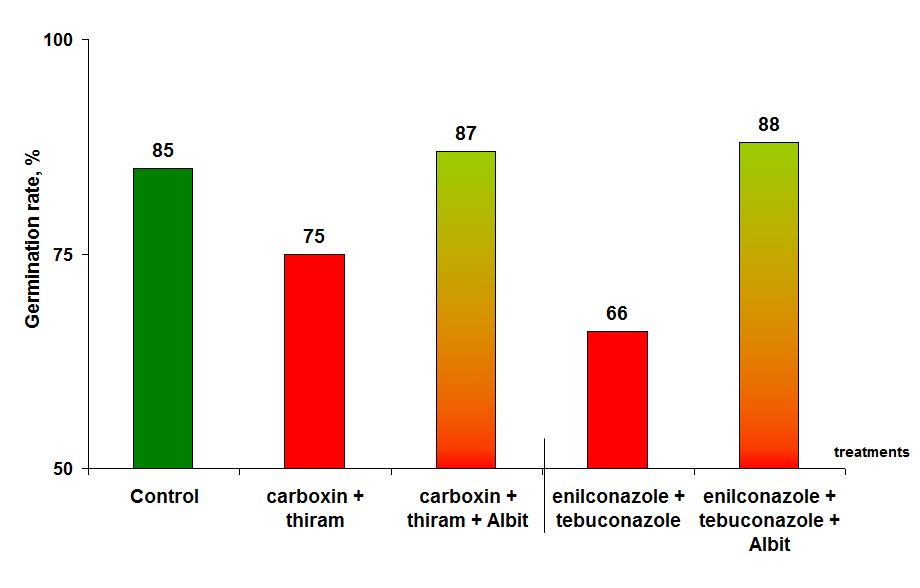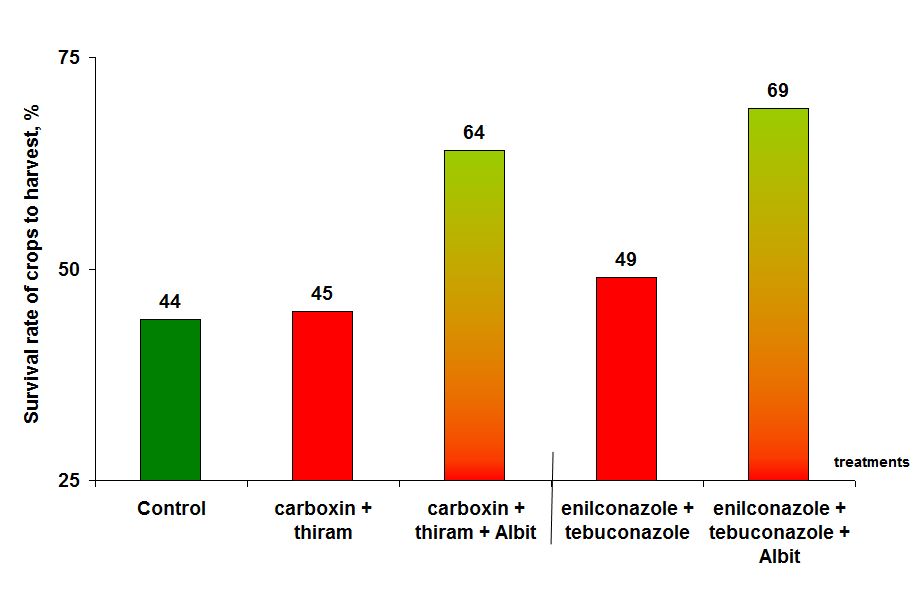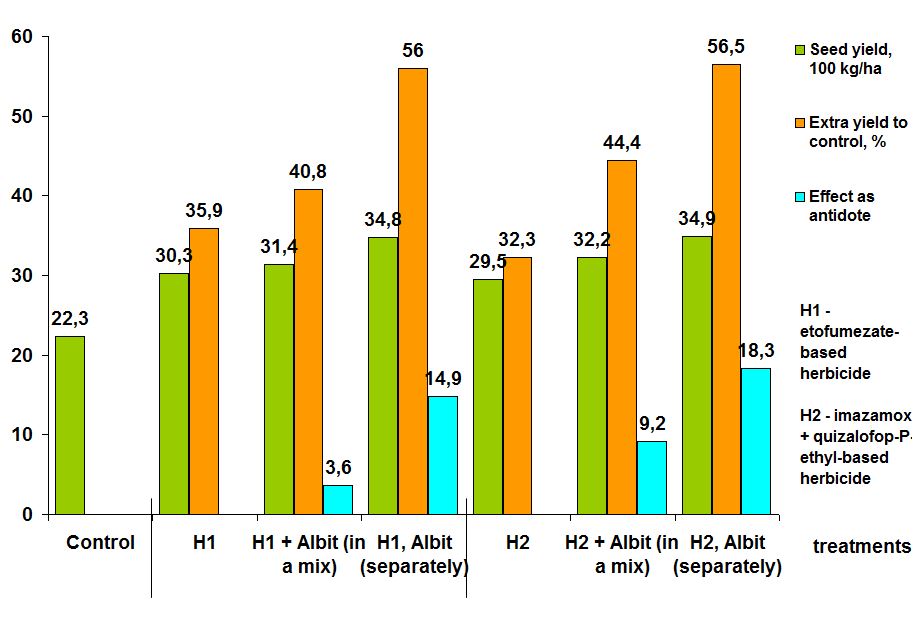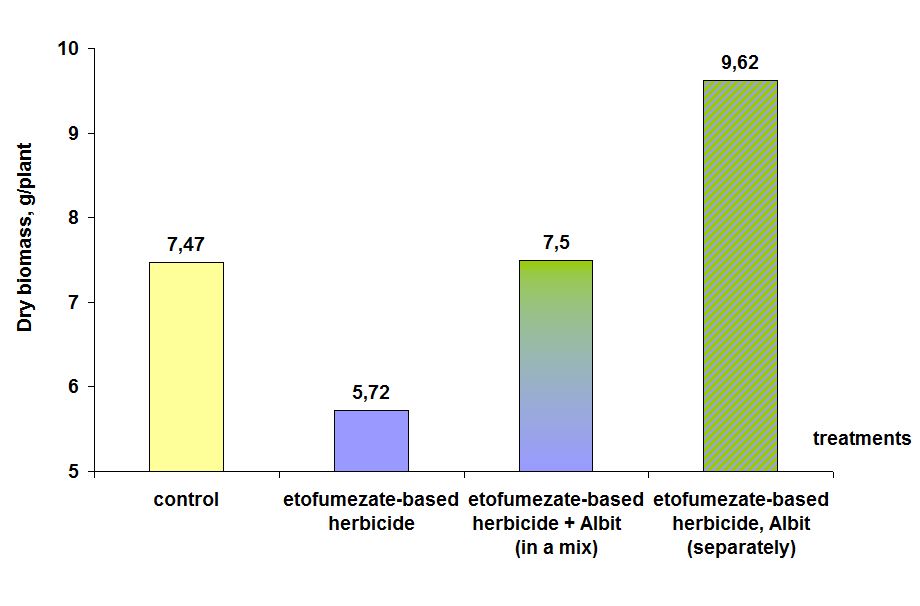|
|
These advantages of lupine and dependence of Russia on the import of protein-containing products highlight the importance of growing of non-alkaloid lupine varieties. However, lupine yield is still far from the productive potential. There are many methods of breeding and cultivation of lupine for solving of this problem. In particular, treatment of plants with growth regulators is effective method. On lupine, Albit is applied as antidote for decrease of side phytotoxic effect of pesticides on crop. In Russia, Albit is officially registered as a plant growth regulator of lupine. Albit increases field germination capacity, accelerates plant growth and development, improves plant resistance to unfavorable conditions of the environment, provides defense against plant diseases. Also, Albit increases lupine yield and improves the yield quality. Since 2001, the effect of Albit on lupine has been tested in the field trials of All-Russian Institute of Vegetable Selection and Seed Breeding (Moscow oblast), Brest Regional Agricultural Experimental Station (Belarus, 2008-2009), All-Russian Scientific Research Institute of Lupine: FGBNU branch “Williams FWRC of fodder production and agroecology” (2019), and other institutes and farms. In 2001 in field trials of All-Russia Institute of Vegetable Selection and Seed Breeding (Moscow oblast) effect of Albit on yellow alkaloid-free lupine was tested. Annual lupine var. Bryanskij-6 was grown on plots 9 m2. Sowing date – May 20, harvest date – the beginning of September. Two methods of treatment were applied: seed treatment and foliar spraying at the budding stage (400 L/hà of working solution). Application rate 30-50 mL/t(hà). As a result, increased field germination of seeds treated with Albit was observed (by 5-10% over control in variant without treatment). After foliar spraying with Albit more active flowering was observed. In all variants yield increase over control was observed, yield was 0.7 t/hà. Maximal yield increase was 14.3% and 15.7% in variants with seed treatment + foliar spraying with Albit in doses 50 mL/t + 30 mL/hà and 50 mL/t + 50 mL/hà, respectively. Field trials were conducted in Belarus (Brest Regional Agricultural Experimental Station, 2008-2009). Effect of Albit was tested on lupine angustifoliate var. Mihail. Two application methods were used: seed treatment (10 L of working solution per 1 tonne) and foliar spraying at the budding stage (300 L/hà of working solution) with doses 40-50 mL/t(hà). Inoculation of seeds with nodule bacteria Rhizobium lupini was applied in some variant with recommended doses. In conditions of a moderately moist growing season of 2008 Albit had a major and stable positive effect on lupine yield. Very wet weather conditions in the first half of the growing season of 2009 contributed to intensive linear growth of narrow-leaved lupine. However, there was a significant fall of flowers. Combination of unfavorable soil and weather factors caused the enhanced branching of plants. Lupine yield in control was 3.35 t/hà and 1.77 t/hà in 2008 and 2009, respectively. However, in spite of such significant differences in control, the positive effect of Albit remained the same. In unfavourable conditions of 2009 positive effect of Albit was even more pronounced. In field trial of 2008 foliar spraying with Albit increased yield by 9.6% to control, in 2009 – by 36.2%. The increased number of seeds per plant was also observed (increase to control was 16.9 pcs.). Variants with Albit and nodule bacteria had a positive effect on lupine yield (see Table). Two-factor dispersion analysis (factor À – inoculation of seeds; factor  – foliar spraying with Albit) shown the following: Rhizobium took part in 60% of yield forming, following sprayings with plant growth regulators – 16%. The interaction of studied factors is also reliable (7%). The significant difference between effects of different stains-inoculants was not detected. Table. Influence of treatments with Albit and nodule bacteria on yield of angustifoliate lupine (Brest Regional Agricultural Experimental Station in Belarus, 2008-2009)
In variants without nodule bacteria treatment, foliar spraying with Albit was more effective, than seed treatment (yield increase to control was 18.8% and 11.3%, respectively). Inoculation of seeds with nodule bacteria gave yield increase ca. 10.6% to control. However, in combination of nodule bacteria with Albit (50 mL/t) yield increase was higher (18.8%). This fact points to a good compatibility of Albit with rhizobial inoculants. Maximum yield increase (24-25% to control) was observed in the group which was sprayed with Albit (40 mL/hà) and inoculated with Rhizobium. Another group, which was complexly treated with Albit (seed treatment + foliar spraying) but not inoculated with rhizobacteria, had a less prominent response than a one-spray group. This result may be due to total underweight of an increased number of seeds. Therefore, to achieve a high yield of lupine, it is recommended to either carry out foliar spraying with Albit at the flower budding stage or to do combined seed treatment with Albit and rhizobacteria with the following foliar spray with Albit. The latter increased lupine yield by 0.35-0.48 tonne/ha. At 2019, All-Russian Scientific Research Institute of lupine (Bryansk Oblast), conducted a series of plot experiments on white lupine var. Michurinsky. The plots covered the area of 25 m3; the experiment was replicated four times. Crops were sowed on the 23rd of April and harvested on the 29th of August (2019). In the first series of the experiments, seeds were treated with 50 ml/tonne of Albit in a tank mix with fungicidal seed treatments (active substance of carboxin + thiram and enilconazole + tebuconazole). Rate of the working solution was 10 L/tonne. Control group was not treated with any seed treatments. In the adverse weather conditions of the 2019 growing season, Albit had a significantly positive effect on the growth and survival rate of white lupine crops. Albit also positively affected the formation of above-ground biomass, development of the root system and root nodules, and the yield of the crops. It was confirmed that Albit acted as an antidote to the chemical seed treatments (Fig. 1, 2). Application of chemical seed treatment to the seeds led to a significant decrease of field germination rate; when Albit was added to the mix, this negative impact was relieved. Mixing Albit with a fungicide with active substance of carboxin + thiram allowed to increase the germination rate by 16%, and the survival rate of crops by the time of harvest was increased by 42.2%. Extra 16.6% of biomass and extra 10.4% of seed yield were also obtained in the Albit group (compared to the seed treatment group). When compared to the effect of fungicide with enilconazole + tebuconazole, Albit group had a 33.3% increase in the germination rate, a 41% survival rate by harvest, a 19% increase of biomass, and a 6.6% increase of a 1000 seed weight. Total yield productivity of lupine in 2019 was only 1.27 tonne/ha due to adverse weather conditions of the growing season. Yields of 2.97 and 3.25 tonne/ha were obtained in groups treated with Albit, which exceeded control by 2.3-2.5 times.
Figure 1. The impact of Albit and different seed treatments on the field germination rate of white lupine crops (All-Russian Scientific Research Institute of lupine Studies, Bryansk Oblast 2019)
Figure 2. The impact of Albit and different seed treatments on the survival rate of white lupine crops by the time of harvest (All-Russian Scientific Research Institute of lupine Studies, Bryansk Oblast, 2019)
Biological effectiveness (BE) of Albit increased by 25-69% when Albit was added to a fungicide with the active substance of carboxin + thiram. BE increased by 10-23% when Albit was added to a fungicide with the active substance of enilconazole + tebuconazole (Fig. 3).
Figure 3. Biological effectiveness of chemical seed treatments and their tank mixes with Albit against diseases of white lupine (All-Russian Scientific Research Institute of lupine Studies, Bryansk Oblast, 2019)
lupine is highly sensitive to the phytotoxic effect of herbicides. Because of this quality, many products that are successfully used on soybean, peas and other legumes are damaging to lupine. They can cause the deformation of seedlings and early seedling death. Currently, there are only a few products that are permitted to be used on weeds of white lupine, and the phytotoxic effect of these products on lupine is still not entirely eliminated. With the above, the second series of the experiments of All-Russian Scientific Research Institute of lupine was conducted on growing plants of white lupine. The experiment examined the antidotal quality of Albit while it was used simultaneously with herbicides containing etofumezate and imazamox + quizalofop-P-ethyl. 30 ml/ha of Albit were: 1) added to tank mix with herbicide and used to spray lupine crops at the stage of 2-4 true leaves, and 2) after using herbicide at the stage of 2-4 true leaves, treating crops with Albit separately at the flower budding stage. Rate of the working solution was 300 L/ha. The control group was not treated with any product, not Albit nor herbicides. The experiments established that the reviewed herbicides had a negative impact on the growth and development of white lupine crops and adding Albit to herbicides relieved the stress of this adverse effect. With Albit, the survival rate of white lupine by the time of harvest increased, together with increased above-ground biomass, improved root growth and nodule development, increased amount of beans, amount of beans in one pod, the weight of seeds on one plant, and increased yield. Yield productivity of the control group was 2.23 tonne/ha. Yield productivity in all treatment groups exceeded the control by values varying from 0.72 to 1.26 tonne/ha. Albit notably acted as an antidote to relieve the effect of herbicides both when the products were used together in tank mix (+3.6…9.2% to yield productivity without Albit), and when plants were treated with Albit separately from herbicides (+14.9…18.3%) (Fig. 4). The latter method of treatment proved to be the most effective and allowed to obtain the highest yield productivity of lupine seed: 3.5 tonne/ha (+56% to control). Using Albit together with herbicides increased the accumulation of biomass of lupine up to 31% (Fig. 5). The survival rate of crops increased up to 32% as well; 1.5 times increase was noted in the development of root system compared to treatment with herbicides only. The peak effect of Albit as an antidote was observed in relation to the herbicide with the active substance of etofumezate. It is important to note that when Albit was used together with herbicides, the effectiveness of herbicides against weeds was not at all affected. As the study discovered, the biological effectivity of herbicides was even higher in the treatment groups in which Albit was applied after herbicide treatment and not together with it. Therefore, in the conditions of this method of application, Albit’s ability to act as an antidote and antistressant to herbicidal stress was the most evident. This quality of Albit has been previously noted on other crops http://www.albit.com/5/2_03_02.php.
Figure 4. The effect of different methods of application of Albit and herbicides on the yield productivity of white lupine seed (All-Russian Scientific Research Institute of lupine Studies, Bryansk Oblast, 2019).
Figure 5. The impact of using Albit and etofumezate-based herbicide on the biomass accumulation of white lupine by the end of growing period (physiological maturity stage) (All-Russian Scientific Research Institute of lupine Studies, Bryansk Oblast, 2019).
Application method. To achieve the best results, conduct seed treatment with 50 mL/t of Albit before sowing, and foliar spraying at the budding stage (ÂBCH 50-60, 30 mL/hà). Using Albit in combination with rhizobacteria (rhizobacterial inoculants) for seed treatment has been proven effective as well. As an antidote, Albit may be applied both in a tank mix with pesticides, and separately from them (after pesticide application, following the recommendations correspondingly).
In the following Table you will find the studies that examined the performance of Albit on lupine, available in English. For all available reports, please see the corresponding table on the Russian
webpage
|
|
|||||||||||||||||||||||||||||||||||||||||||||||||||||||||||||||||||||||||||||||||||||||||||||||||||||||||||||||||||
Terms and Conditions
|
|
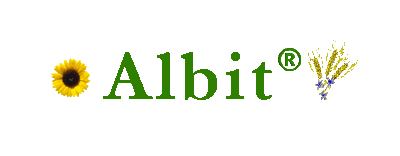

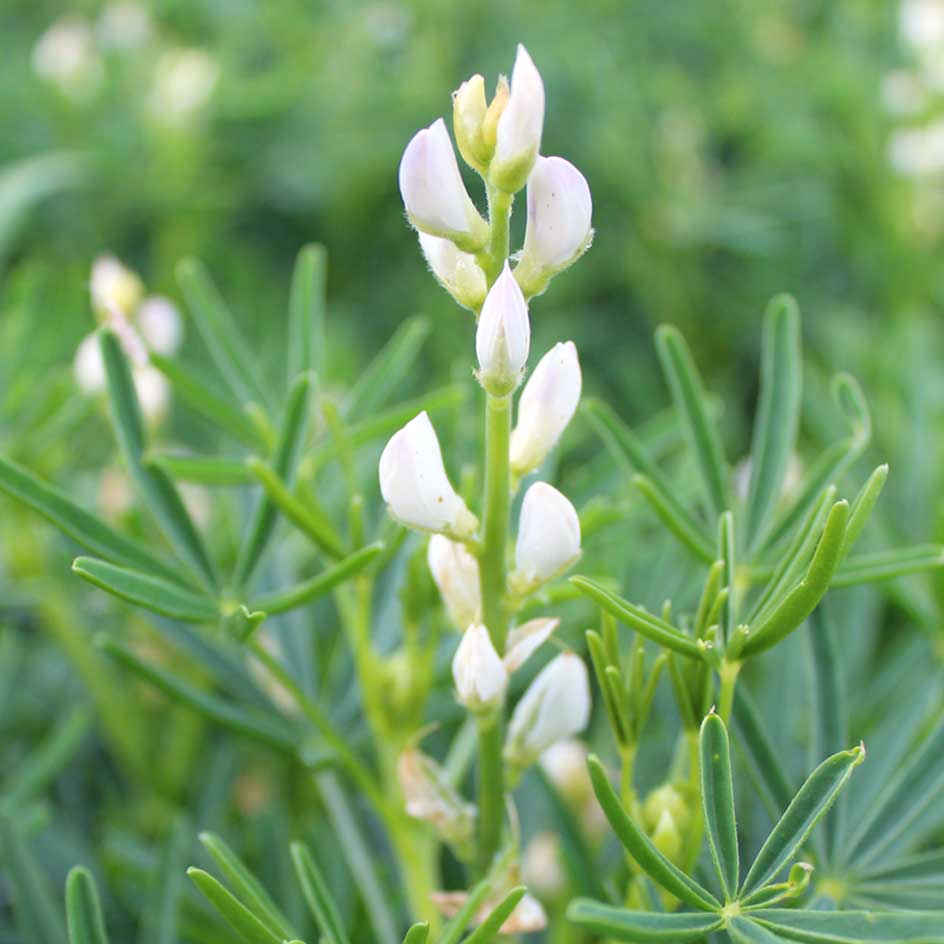 In
recent years, lupine has been taking an important place in the sown areas all
over the world. In EU and Australia expansion of areas with lupine is observed,
which is associated with breeding of resistant non-alkaloid varieties of lupine.
Lupine contains 35-42% of protein, which is balanced in amino acid composition.
The significant content of essential amino acids in the protein, as well as
number of functional and technological properties of lupine flour, which exceed
the properties of soy one, make lupine the most promising additive during food
production. Lupine protein, in contrast to soy protein, practically does not
contain inhibitors of proteolytic enzymes and almost does not cause allergic
reactions. In this regard, white lupine flour is increasingly used as an additive
to bakery and confectionery. Lupine seeds also contain oil, which is similar
to olive oil. This allows non-alkaloid lupine to take the place of soybean
where it can not be grown, for example because of low soil pH.
In
recent years, lupine has been taking an important place in the sown areas all
over the world. In EU and Australia expansion of areas with lupine is observed,
which is associated with breeding of resistant non-alkaloid varieties of lupine.
Lupine contains 35-42% of protein, which is balanced in amino acid composition.
The significant content of essential amino acids in the protein, as well as
number of functional and technological properties of lupine flour, which exceed
the properties of soy one, make lupine the most promising additive during food
production. Lupine protein, in contrast to soy protein, practically does not
contain inhibitors of proteolytic enzymes and almost does not cause allergic
reactions. In this regard, white lupine flour is increasingly used as an additive
to bakery and confectionery. Lupine seeds also contain oil, which is similar
to olive oil. This allows non-alkaloid lupine to take the place of soybean
where it can not be grown, for example because of low soil pH.